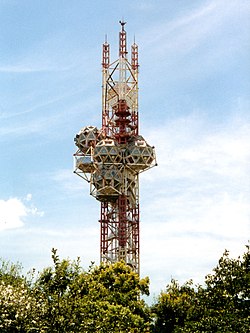Expo '70
| Expo '70 日本 万 国 博 覧 会 |
|
|---|---|
 The Expo Tower |
|
| motto | "Progress and Harmony for Humanity" |
| General | |
| Exhibition space | 330 ha |
| Number of visitors | 64.218.770 |
| BIE recognition | Yes |
| participation | |
| countries | 77 countries |
| Place of issue | |
| place | Osaka |
| terrain |
Suita coordinates: 34 ° 48 ′ 31 ″ N , 135 ° 32 ′ 6.8 ″ E |
| calendar | |
| opening | March 15, 1970 |
| closure | September 13, 1970 |
| Chronological order | |
| predecessor | Expo 67 |
| successor | Expo 75 |
The world exhibition Expo '70 ( Japanese 日本 万 国 博 覧 会 , nihon bankoku hakurankai or 大阪 万博 , Ōsaka bampaku ) took place from March 15 to September 13, 1970 in Suita , a suburb of the Japanese city of Osaka . It was the first world exhibition in Japan and the first ever on the Asian continent .
77 countries presented themselves at the exhibition, 64,218,770 visitors were registered within six months. 1,040 exhibitors were represented. The exhibition area was 330 hectares . This made the Expo '70 one of the largest and best-attended world exhibitions ever. The motto of the expo was Jinrui no Shimpo to Chōwa ( 人類 の 進 歩 と 調和 , dt. "Progress and harmony for humanity").
history
Even at the time of the first world exhibitions there were ideas for a world exhibition in Japan, but their implementation failed due to a lack of interest from abroad. In the 20th century, too, several attempts failed: The world exhibition planned for 1912 had to be canceled due to the death of Emperor Meiji , and afterwards the Second World War made it impossible to hold a world exhibition in Japan.
When the Bureau International des Expositions approved a world exhibition in Japan in 1966 , this was the opportunity for Japan to present itself as the third economic power behind the two superpowers, the USA and the Soviet Union .
Multimedia was the big trend at Expo '70: projections of films and slides with background sound, projections on fixed and moving surfaces, all-round projections - multimedia was omnipresent.
architecture
At the Expo '70, metabolistic structures by Japanese architects with constructivist support structures for hanging structures dominated. In contrast, there was the massive Soviet pavilion: at 107 meters, it was the second tallest building on the Expo site after the Expo Tower and symbolized an unfurling red flag. The USA pavilion was an air dome into which air was blown from outside under a thin plastic film.
The German pavilion is particularly well-known from this period. As a spherical auditorium, it enabled the audience to receive sound in the equatorial plane of a spherical azimuthal arrangement of hundreds of loudspeakers. This was the first truly three-dimensional rendering of music. The concept for the multimedia pavilion was created in collaboration between Karlheinz Stockhausen and Otto Piene .
Reuse
Almost all Expo buildings were demolished, the area was converted to the "Expo Memorial Park" (万博 記念 公園, Bampaku kinen kōen). The Osaka Expo '70 stadium , which was built for the exhibition and where the Japanese professional football club Gamba Osaka plays, has been preserved. The large National Museum of Ethnology was rebuilt in the 1970s .
Picture gallery
literature
- Winfried Kretschmer: History of the world exhibitions . Campus, 1999, ISBN 3-593-36273-2 .
- Erik Mattie: World's Fair . Belser, 1998, ISBN 3-7630-2358-5 .
Individual evidence
- ↑ Karlheinz Stockhausen “Ball Auditorium” , accessed on January 12, 2014.
Web links
- Official Homepage of Expo '70 (Japanese)
- Expo 1970. Bureau International des Expositions (English). Retrieved March 23, 2017 .
- Expo '70 in the Expo-Museum (English)
- Expo '70 (Banpaku) Stadium (English)
- Ball Auditorium








